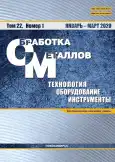Expanded Titanium Meshes Based on Deformational Cutting
- Authors: Nikolai Z.N.1
-
Affiliations:
- Issue: Vol 22, No 1 (2020)
- Pages: 41-53
- Section: TECHNOLOGY
- URL: https://journal-vniispk.ru/1994-6309/article/view/301972
- DOI: https://doi.org/10.17212/1994-6309-2020-22.1-41-53
- ID: 301972
Cite item
Full Text
Abstract
Keywords
About the authors
Z. N. Nikolai
Email: zoubkovn@bmstu.ru
D.Sc. (Engineering), Professor, Bauman Moscow State Technical University, 5 Baumanskaya 2-ya, Moscow, 105005, Russian Federation, zoubkovn@bmstu.ru
References
- Patent EP 0727269 B1. Method of producing a surface with alternating ridges and depressions and a tool for carrying out the said method / N.N. Zubkov, A.I. Ovchinnikov. – Publ. date 13.09.2000.
- Ельчинов В.П., Митин Е.В. Новые нержавеющие кожухотрубные конденсаторы водяного охлаждения: сочетание эффективности и надежности // Холодильный бизнес. – 2014. – № 1. – С. 16–22.
- Investigation of heat transfer in evaporator of microchannel loop heat pipe / A.A. Yakomaskin, V.N. Afanasiev, N.N. Zubkov, D.N. Morskoy // Journal of Heat Transfer. – 2013. – Vol. 135, iss. 10. – P. 101006. – doi: 10.1115/1.4024502.
- Novel electrical joints using deformation machining technology. Pt. 2. Experimental verification / L. Solovyeva, N. Zubkov, B. Lisowsky, A. Elmoursi // IEEE Transactions on Components, Packaging, and Manufacturing Technology. – 2012. – Vol. 2, N 10. – P. 1718–1722. – doi: 10.1109/TCPMT.2012.2199755.
- Шуляк Я.И. Силы резания при деформационном упрочнении аустенитной стали методом деформирующего резания // Известия вузов. Машиностроение. – 2019. – № 1. – С. 12–19. – doi: 10.18698/0536-1044-2019-1-12-19.
- Зубков Н.Н., Васильев С.Г., Попцов В.В. Особенности закалочного деформирующего резания // Обработка металлов (технология, оборудование, инструменты). – 2018. – Т. 20, № 2. – С. 35–49. – doi: 10.17212/1994-6309-2018-20.2-35-49.
- Зубков Н.Н. Однопроходное формирование резьб на пластичных металлах деформирующим резанием // Обработка металлов (технология, оборудование, инструменты). – 2019. – Т. 21, № 2. – С. 6–17. – doi: 10.17212/1994-6309-2019-21.2-6-17.
- Zubkov N.N., Bityutskaya Yu.L., Voinov S.A. Shaping of heat exchanger pins by deformational cutting // Russian Engineering Research. – 2016. – Vol. 36, N 2. – P. 81–85. – doi: 10.3103/S1068798X16020258.
- Zubkov N.N., Sleptsov A.D. Influence of deformational cutting data on parameters of polymer slotted screen pipes // Journal of Manufacturing Science and Engineering. Transactions of the American Society of Mechanical Engineers. – 2016. – Vol. 138, N 1. – P. 011007-1–011007-7. – doi: 10.1115/1.4030827.
- Титансодержащие сетчатые эндопротезы, как перспективная группа имплантатов для пластики брюшной стенки / А.А. Казанцев, В.В. Паршиков, К.А. Шемятовский, А.И. Алехин, Д.Л. Титаров, А.А. Колпаков, С.В. Осадченко // Хирургия. Журнал им. Н.И. Пирогова. – 2016. – № 4. – С. 86–95. – doi: 10.17116/hirurgia2016486-95.
- LeBlanc K.A. Implants used for hernioplasty // Laparoscopic and robotic incisional hernia repair / ed. by K. LeBlanc. – Cham: Springer, 2018. – P. 41–84.
- Федоров С.А., Самедова Д.А. Опыт применения титанового шелка в стоматологии хирургической // Бюллетень медицинских Интернет-конференций. – 2018. – Т. 8, № 7. – С. 289.
- Бадалян А.А., Чернавский А.Ф., Петров И.А. Клинико-психологические основы формирования качества жизни при восстановлении биологического рельефа кости с помощью титанового шелка // Проблемы стоматологии. – 2018. – Т. 14, № 3. – С. 56–63.
- Smith D., Graciano C., Martinez G. Recent patents on expanded metal // Recent Patents on Materials Science. Continued as Current Materials Science. – 2009. – Vol. 2, N 3. – doi: 10.2174/1874464810902030209.
- Sparks T., Chase G. Filters and filtration handbook. – 6th ed. – Boston, MA: Elsevier, 2015. – 444 p. – doi: 10.1016/C2012-0-03230-9.
- Purchas D., Sutherland K. Handbook of filter media. – 2nd ed. – Oxford: Elsevier Advanced Technology, 2002. – 572 p. – ISBN 9781856173759.
- Strength to weight ratio research boosts expanded metal // Aircraft Engineering and Aerospace Technology. – 2006. – Vol. 78, N 5. – doi: 10.1108/aeat.2006.12778ead.020.
- Kooistra G.W., Wadley H. Lattice truss structures from expanded metal sheet // Materials & Design. – 2007. – Vol. 28, N 2. – P. 507–514. – doi: 10.1016/j.matdes.2005.08.013.
- On the influence of structural defects for honeycomb structure / Z. Wang, Z. Li, W. Zhou, D. Hui // Composites Part B: Engineering. – 2018. – Vol. 142, iss. 1. – P. 183–192. – doi: 10.1016/j.compositesb.2018.01.015.
- Design and fabrication of aluminum honeycomb structures based on origami technology / L. Wang, K. Saito, Y. Gotou, Y. Okabe // Journal of Sandwich Structures & Materials. – 2019. – Vol. 21, iss. 4. – P. 1224–1242. – doi: 10.1177/1099636217714646.
Supplementary files






